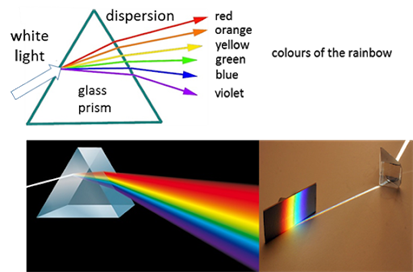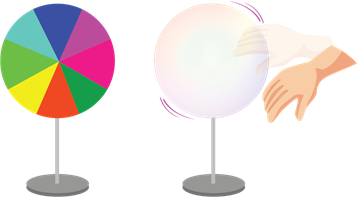
PUMPA - SMART LEARNING
எங்கள் ஆசிரியர்களுடன் 1-ஆன்-1 ஆலோசனை நேரத்தைப் பெறுங்கள். டாப்பர் ஆவதற்கு நாங்கள் பயிற்சி அளிப்போம்
Book Free DemoSunlight is white or coloured:
- Generally, we think sunlight is white in colour, but it is not white in nature. It is made up of seven colours called VIBGYOR (violet, indigo, blue, green, yellow, orange and red). All these colours mix to form white light.
- Visible light is a spectrum of several waves with different wavelength ranges from 400 nm to 700 nm, out of these, violet has a shorter wavelength whereas red's wavelength is longer.
- If we pass sunlight into some optical devices like prisms, the white light gets split into seven component colours.
V - Violet
I - Indigo
B - Blue
G - Green
Y - Yellow
O - Orange
R - Red
Let us discuss about prism,

Dispersion of light
- A prism is made up of transparent material such as glass or plastic with at least two flat surfaces that form an acute angle (less than 90 degrees).
- If we pass sunlight into some optical devices like prisms, the white light gets split into seven component colours. This process of the splitting of light into its constituents is called 'dispersion of light'.
Newton disc:
We have studied that white light is made up of seven colours. Newton proved that experimentally. He suggested mixing different colours to make white colour by setting an arrangement called 'Newton disc'. It is a cardboard disc with seven equal sectors; each sector is painted with different colours, such as violet, indigo, blue, green, yellow, orange, and red. When the disc is rotated quickly, the retina of our eyes perceives that the disc is white. Using this disc, we prove that white is made up of seven colours called VIBGYOR.

Newton disc
We know that a white shirt will reflect white light, which consists of seven different colours. When we see the white shirt through the yellow gelatin paper, we see it as yellow. Therefore, we can say that the yellow gelatin paper did not allow any other colour except yellow to pass through it. Likewise, red gelatin paper allows only red light, and blue gelatin paper allows only blue light.
Synthesis of colour:
Creating a new colour by mixing various proportions of two (or) three distinct colours of light is called the synthesis of colour. The distinct colours are Red, Green, and Blue, and they are called primary colours.
| By mixing equal proportions of two primary colours gives a secondary colour (Magenta, cyan and yellow are some examples of secondary colours). | By mixing equal proportions of three primary colours, we get a white colour |
Red + Blue = Magenta Blue + Green = Cyan Green + Red = Yellow (All primary colours should be in equal proportion.) | Red + Blue + Green = White (All primary colours should be in equal proportion.) |

Synthesis of colour
Reference:
https://commons.wikimedia.org/wiki/File:Dispersion_of_light.png